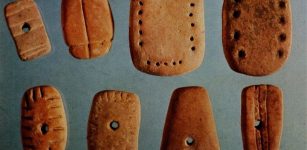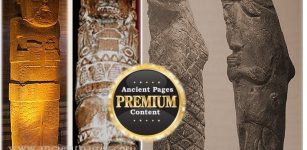Tullus Hostilius: Warrior King Of Rome, Who Succeeded Numa Pompilius And Feared Prophecies
A. Sutherland - AncientPages.com - Traditionally counted, there were seven kings of Rome. However, it is difficult to attribute their deeds to a respective ruler, because ancient records were destroyed in the Sack of Rome by the Gauls, 390 BC.

Tulius-Hostilius was the third of the Kings of Rome. Source
According to ancient tradition, the warlike king (and founder) of the city, known as Romulus, was succeeded by the Numa Pompilius, who was not a warrior king but rather a statesman and politician whose reign was characterized by peace and tranquility.
Contrary to Numa, his successor, Tullus Hostilius was a warrior king, much more interested in conquests than peace in the Empire. His reign was filled with warlike activities.
He was the grandson of Hostus Hostilius, a nobleman of ancient Rome during the reign of Romulus, who had fought with Romulus and died during the Sabine invasion of Rome.
Demolition Of Alba Longa
One of the most memorable historical events during the reign of Tullus was the destruction of Alba Longa.
Legend says that in ancient times, Alba Longa was the oldest city in the province of Lazio in the Alban Mountains southeast of Rome. Alba Longa was founded in 1152 BC as a new home village for the Trojan refugees. Rome's founders Romulus and Remus were descended from the city's royal family, but after Rome's founding, the cities became competitors, according to the legend.
It is traditionally stated that Alba Longa was destroyed by the Romans during Tullus Hostilius in the 600s BC. However, archaeologists have only found burial sites in the area, never any city, which would suggest that the city has never existed. Although the people of Alba Longa were made a vassal state, their king Mettius Fufetius betrayed Rome. Tullus ordered Alba Longa to be destroyed and its people were forced to migrate to Rome and become Roman citizens.
The third king of Rome, Tullus Hostilius participated in several other successful battles, the so-called Roman-Etruscan Wars, which took place for a longer period of time and from the earliest stages of the history of Rome. However, information about these military encounters is very limited.
One thing is certain, during the reign of this king, Rome expanded its borders like never before.
Interregnum ‘Gaps’ Between Reigns Of Roman Kings
Tullus Hostilius becomes king after a short interregnum. In the Roman Empire, there were several imperial interregnum (‘gaps’) between the reigns of the Roman kings. It could even take up a few years. According to Livy, the interregnum which followed the death of Romulus was of one-year-long while upon the death of Numa, the interregnum lasted longer than was necessary for the ceremony of the election, the next king, Tullus Hostilius.
Warrior King Tullus Had Not Much Time For Religious Activities
According to the Roman historian, Livy (64 or 59 BC-AD 12 or 17), Tullus showed very little interest in religious ceremonies and rituals. He simply considered them unworthy of a king's attention.

During the reign of king Tullus Hostilius, Rome expanded its borders like never before. (Painting by Rembrandt).
Livy reports in his book of Roman History, however, that at the close of Tullus’ reign, the great city of Rome was affected by some ominous prophecies. Among others, volcanic activity "...there had been a shower of stones on the Alban Mount" commonly known as Monte Cavo.
In response to it, a public religious festival of nine days was held – a novendialis, and a loud voice was heard on the summit of the mount complaining that the people had failed to show devotion to their former gods, and a plague struck in Rome.
King Tullus became ill and was filled with superstition. He knew that his predecessor, Numa Pompilius was a religious man but he was not. He ignored the religious practices recommended by Numa.
Now, it was perhaps time to introduce some changes in his warrior-like life and reign. King Tullus made attempts to follow certain instructions to the religious practices of Numa Pompilius. Unfortunately, he did not follow the instructions correctly when he tried to sacrifice to the god Jupiter.
Tullus Hostilius, his family, and his house were struck by lightning and so his reign ended in about 642 BC.
Written by – A. Sutherland - AncientPages.com Senior Staff Writer
Copyright © AncientPages.com All rights reserved. This material may not be published, broadcast, rewritten or redistributed in whole or part without the express written permission of AncientPages.com
Expand for referencesReferences:
Hooke N. The Roman history, from the building of Rome to the ruin of the commonwealth
More From Ancient Pages
-
 London’s Oldest Theater Red Lion Discovered Beneath Whitechapel
Archaeology | Jun 10, 2020
London’s Oldest Theater Red Lion Discovered Beneath Whitechapel
Archaeology | Jun 10, 2020 -
 What Is The Codex Sinaiticus And What Does It Mean?
Ancient History Facts | Feb 5, 2019
What Is The Codex Sinaiticus And What Does It Mean?
Ancient History Facts | Feb 5, 2019 -
 Mysterious Gigantic Jars Of Unknown Origin Discovered Worldwide
Artifacts | Dec 27, 2018
Mysterious Gigantic Jars Of Unknown Origin Discovered Worldwide
Artifacts | Dec 27, 2018 -
 Takshashila: Renowned Learning Center That Attracted Buddhist Masters, Disciples And Students Of The World
Featured Stories | Sep 13, 2021
Takshashila: Renowned Learning Center That Attracted Buddhist Masters, Disciples And Students Of The World
Featured Stories | Sep 13, 2021 -
 Intrepid Southern Voyage In The Wake Of Early Waka
Archaeology | Jun 28, 2023
Intrepid Southern Voyage In The Wake Of Early Waka
Archaeology | Jun 28, 2023 -
 Ancient Warfare And Continuous Rise In Global Population – Is There A Connection?
Archaeology | Sep 13, 2021
Ancient Warfare And Continuous Rise In Global Population – Is There A Connection?
Archaeology | Sep 13, 2021 -
 Delphic Mysteries – Unusual Prophecy And Birth – Part 1
Ancient Mysteries | Mar 27, 2023
Delphic Mysteries – Unusual Prophecy And Birth – Part 1
Ancient Mysteries | Mar 27, 2023 -
 Strange Mummies Of Venzone: Ancient Bodies That Never Decompose Remain An Unsolved Mystery
Featured Stories | Oct 22, 2018
Strange Mummies Of Venzone: Ancient Bodies That Never Decompose Remain An Unsolved Mystery
Featured Stories | Oct 22, 2018 -
 Seven Bronze Age Swords And Large Hoard Of Slavic Coins Found In Germany
Archaeology | Dec 4, 2023
Seven Bronze Age Swords And Large Hoard Of Slavic Coins Found In Germany
Archaeology | Dec 4, 2023 -
 What Does The Mexican Codex Map Represent?
Ancient History Facts | May 21, 2018
What Does The Mexican Codex Map Represent?
Ancient History Facts | May 21, 2018 -
 Deadly Ancient Secrets Of Queen Hatshepsut’s Flacon
Artifacts | Mar 18, 2017
Deadly Ancient Secrets Of Queen Hatshepsut’s Flacon
Artifacts | Mar 18, 2017 -
 Ancient DNA Reveals Unknown Genetic Exchanges Between North And South America
Archaeology | Nov 12, 2018
Ancient DNA Reveals Unknown Genetic Exchanges Between North And South America
Archaeology | Nov 12, 2018 -
 Goddess Artemis – One Of The Most Respected Olympians
Featured Stories | Oct 1, 2016
Goddess Artemis – One Of The Most Respected Olympians
Featured Stories | Oct 1, 2016 -
 Ancient DNA Reveals How European Skin, Eye, And Hair Color Evolved Over The Past 45,000 Years
DNA | Feb 24, 2025
Ancient DNA Reveals How European Skin, Eye, And Hair Color Evolved Over The Past 45,000 Years
DNA | Feb 24, 2025 -
!["That most enduring of romantic images, Aristotle tutoring the future conqueror Alexander".[147] Illustration by Charles Laplante [fr], 1866](https://www.ancientpages.com/wp-content/uploads/2017/06/aristotleraslexanderlyceum-307x150.jpg) Aristotle: First Book Collector Who Assembled The First Great Library Of Antiquity
Featured Stories | Jun 23, 2017
Aristotle: First Book Collector Who Assembled The First Great Library Of Antiquity
Featured Stories | Jun 23, 2017 -
 Future Of Thornborough Henges Secured – Stonehenge Of The North Preserved For The Nation
News | Feb 3, 2023
Future Of Thornborough Henges Secured – Stonehenge Of The North Preserved For The Nation
News | Feb 3, 2023 -
 Mysterious Jars In Laos – Long-Lasting Mystery Is Still Unsolved
Archaeology | May 20, 2019
Mysterious Jars In Laos – Long-Lasting Mystery Is Still Unsolved
Archaeology | May 20, 2019 -
 Intriguing Sumerian Clay Tokens – An Ancient ‘Book Keeping’ System Used Long After Writing Appeared
Artifacts | Jul 8, 2017
Intriguing Sumerian Clay Tokens – An Ancient ‘Book Keeping’ System Used Long After Writing Appeared
Artifacts | Jul 8, 2017 -
 Shining Swords: Magical Artifacts That Symbolized Power, War, Punishment And Righteousness
Featured Stories | Nov 20, 2024
Shining Swords: Magical Artifacts That Symbolized Power, War, Punishment And Righteousness
Featured Stories | Nov 20, 2024 -
 Mysterious Water Indians: Brotherhood Of Semi-Divine Beings Described As Half Men And Half Fish
Ancient Mysteries | Jul 8, 2014
Mysterious Water Indians: Brotherhood Of Semi-Divine Beings Described As Half Men And Half Fish
Ancient Mysteries | Jul 8, 2014
